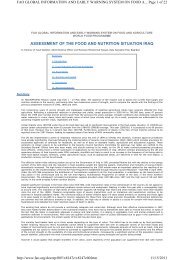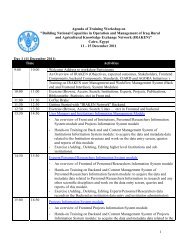Vermiculture in Egypt: - FAO - Regional Office for the Near East and
Vermiculture in Egypt: - FAO - Regional Office for the Near East and
Vermiculture in Egypt: - FAO - Regional Office for the Near East and
You also want an ePaper? Increase the reach of your titles
YUMPU automatically turns print PDFs into web optimized ePapers that Google loves.
were ranged from 3.04 to 252.0 g <strong>in</strong> different treatments (50 kg P2O5 content basis)<br />
(Table 6.5).<br />
Table 6.5. Average values* (±SD) of physio-chemical parameters of water, primary<br />
productivity of phytoplankton <strong>and</strong> f<strong>in</strong>al body weights <strong>and</strong> fish production of<br />
Cypr<strong>in</strong>us carpio <strong>in</strong> various treatments.<br />
Parameters Control (T-1) Compost<br />
(T-2)<br />
59<br />
Diammonium<br />
phosphate<br />
(T-3)<br />
Vermicompost<br />
(T-4)<br />
Temperature (˚C) 30.0 ± 4.3 30.0 ± 5.1 30.0 ± 4.9 30.00 ± 5.5<br />
pH 7.06 ± 0.4 7.26 ± 0.6 7.14 ± 0.1 7.43 ± 0.6<br />
Dissolved oxygen (mg l -1 ) 6.01 ± 0.9 6.21 ± 1.1 7.74 ± 1.0 7.02 ± 1.2<br />
Ortho phosphate (mg l -1 ) 0.09 ± 0.09 0.19 ± 0.06 0.52 ± 0.10 0.30 ± 0.14<br />
Organic phosphate (mg l -1 ) 0.08 ± 0.19 0.27 ± 0.15 0.20 ± 0.14 0.35 ± 0.21<br />
Total phosphate (mg l -1 ) 0.10 ± 0.10 0.66 ± 0.16 0.88 ± 0.25 0.68 ± 0.21<br />
NO3–N (mg l -1 ) 0.06 ± 0.08 0.12 ± 0.06 0.28 ± 0.03 0.16 ± 0.04<br />
Total <strong>in</strong>organic N (mg l -1 ) 0.06 ± 0.005 0.40 ± 0.02 0.80 ± 0.04 0.62 ± 0.03<br />
Total <strong>in</strong>organic nitrogen (N)/total 1.6 0.61 0.90 0.91<br />
phosphate (P)<br />
Community respiration (mg C m -2 h -<br />
1<br />
)<br />
20.13 ±±9.3 28.13 ± 12.5 35.79 ± 18.2 38.58 ± 13.1<br />
F<strong>in</strong>al mean body weight (g) 18.24 ± 2.3 22.25 ± 3.6 39.50 ± 4.3 45.77 ± 3.9<br />
Fertilizer/manure added (g) 0 252 3.04 99<br />
Stock<strong>in</strong>g density 10.00 10.00 10.00 10.00<br />
Initial average <strong>in</strong>dividual length 1.40 ± 0.02 1.40 ± 0.02 1.40 ± 0.02 1.40 ± 0.02<br />
(cm)<br />
Initial average <strong>in</strong>dividual weight (g) 2.40 ± 0.01 2.40 ± 0.03 2.40 ± 0.04 2.40 ± 0.02<br />
F<strong>in</strong>al average <strong>in</strong>dividual length (cm) 4.20 ± 0.03 6.80 ± 0.06 7.60 ± 0.04 8.80 ± 0.07<br />
F<strong>in</strong>al average <strong>in</strong>dividual weight (g) 3.76 ± 0.01 8.29 ± 0.05 12.92 ± 0.03 16.76 ± 0.07<br />
Growth <strong>in</strong>crement (g fish -1 day -1 ) 0.0151 0.0654 0.1169 0.1595<br />
Production of fish (kg ha -1 90 day-1) 385.92 1,952.64 3080.45 3,970.56<br />
Total weight ga<strong>in</strong> (TWG) (g fish -1 ) 0.57 2.45 4.38 5.98<br />
Survival (%) 85 88 87 90<br />
*Each average value applies to 90 days samples.<br />
Source: Chakrabarty et al. (2009).<br />
Where:<br />
Absolute growth (AG) = f<strong>in</strong>al body weight - <strong>in</strong>itial body weight<br />
Growth <strong>in</strong>crement (GI) = f<strong>in</strong>al body weight - <strong>in</strong>itial body weight /<br />
number of culture days after fish <strong>in</strong>troduction<br />
Total weight ga<strong>in</strong> (TWG) = f<strong>in</strong>al body weight - <strong>in</strong>itial body weight /<br />
<strong>in</strong>itial body weight<br />
The dem<strong>and</strong> <strong>for</strong> organically cultured food <strong>for</strong> human consumption is <strong>in</strong>creas<strong>in</strong>g across<br />
<strong>the</strong> globe <strong>and</strong> <strong>for</strong> this reason organic aquaculture is <strong>the</strong> need of <strong>the</strong> present time. Wide<br />
variety of organic manures such as grass, leaves, sewage water, livestock manure,<br />
domestic wastes, night soil <strong>and</strong> dried blood meal have been used.<br />
6.4. Possibilities of worms as animal feed <strong>in</strong> <strong>Egypt</strong>:<br />
For a long time, extensive fish farm<strong>in</strong>g was <strong>the</strong> type practiced <strong>in</strong> <strong>Egypt</strong>, where only<br />
chemical <strong>and</strong>/or organic fertilizers were applied <strong>for</strong> promot<strong>in</strong>g <strong>the</strong> natural productivity<br />
of ponds. Agricultural by-products such as wheat bran <strong>and</strong> rice bran were used <strong>for</strong><br />
supplementation <strong>in</strong> some farms. As <strong>the</strong> technology of fish farm<strong>in</strong>g has developed,





